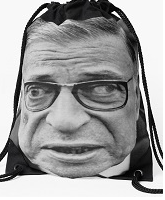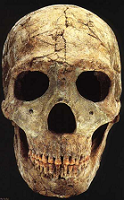4
















| Thumbs Up |
| Received: 8,095 Given: 10,128 |

In the Upper Paleolithic, Mesolithic in northern and postglacial areas of Europe from Brittany and the Iberian Peninsula to the north-east Ukraine and the center of modern Russia very broad-protomorphic Caucasoid types were spread, the area which was subsequently broken and gradually decreased due to the expansion from the south of very dolichocranial Caucasians, Corded ware culture carriers in particular. (Denisova, 1980).
The spread of broad-faced proto-European racial types was, at least until the late Bronze Age, wide enough and in the steppe zone (Shevchenko, 1985).
V.V. Bunak considered proto-Europeoid and lappoid types to be united: more archaic lappoid variants preserved and evolved in a special "conservative" direction in the more remote and isolated areas of the North-Eastern Europe and Scandinavia, where they survived to this day in the form of modern anthropological type of Samis, while in the south there was a process "baltizisation", IE the evolution of ancient protomorphic flat-faced type in Caucasoid direction, and secondly their mix with advancing from the south Europoids.
Antropologia, E.N. Chrisanfova, I.V. Perevozchikov, 2005 y.:
Main thesises:
1. Among europoids types similar to Mesolithic and Upper Paleolithic types are found.
2. Often thoose types don't have continuous areal and don't make up the majority of population of any region.
3. Areas with highest concentration of thoose types are : British Islands, Scandinavia, in Belgium and central Germany, also in mountain areas of Europe adn North-Africa.
4.During studying of physical appearence of modern population of thoose areas (especially Ireland) it's possible to, with some probability, determine separate additional traits of Upper-paleolithic and Mesolithic populations.
5.Overall the traits of suck populations are: High height, broad shoulders, big chest, big head, strongly or moderatly developed brow ridge, broad and tall forehead, face is broad and somewhat flattened, big mouth with moderate thickness of lips, pronounced nasolabial folds, lower jaw is broad and tall, with prominent chin, medium sized or big nose with straight or concave profile, hair is light-brown, often with reddish undertone, body and faicial hair is developed moderately, eye colour is mixed or light, skin colour is very pale with tendecy towards freckled skin.
6. In some Mountain regiouns (Montenegro and Caucasus) population with similar physical appearence exist, but they are usually more pigmented and have higher frequences of convex noses. there are substantial grounds for believing, that in thoose mountain shelters paleoeuropoid types were partially preserved.
7. In 3-2 milleniums B.C. in steppe zone of Eurasia from Dnieper to Altaye-Sayan region the similar in appearence to Paleoeuropoid type was widespread.
Examples (paleoeuropoid traits are expressed to a greater or lessser degree)





















| Thumbs Up |
| Received: 2,896 Given: 852 |

Why haven't I seen any skulls that represent this type in the fossil record?
It seems like some of them fall into the Borreby type, which is based on the Borreby skull, supposedly a dinaricized Cro-Magnid.














| Thumbs Up |
| Received: 8,095 Given: 10,128 |

"Cromagnoid" - a relic term from anthropological classifications of the early twentieth century and obsolete morphological and typological approach. Today, is of historical interest only and not used in modern scientific racial taxonomy.
In older classifications used to describe the massive Northern hypermorphic (broad-faced) types (Felid, Bruenn, Borreby, Tyudal etc.) which, in the original point of view originate from the Upper Paleolithic variants of Cro-magnon type.
However, "Upper Paleolithic complex represents only a generalized European variant and does not match any of the later types" [Bunak, 1980].
In the Upper Paleolithic "any trends of the race formation is not yet fully developed, and only to a small extent outlined the continuity with the current racial complexes" [Zubov, 2004]. All fossil neanthropines of Paleolithic Europe united in one particular, polymorphic group and opposed to modern humanity [Bunak, 1980; Zubov, 2004]. The earliest massive hypermorphic Nordic types have a late Mesolithic origin at max. [Alekseev, 1985, 2007].
Despite all this, outside of the scientific literature, many use the term "Cromagnoid" for massive hypermorphic Neolithic anthropological complexes, which is from a scientific point of view very incorrectly. In modern Russian anthropology to describe massive hypermorphic types of Eurasia of Late Mesolithic, Neolithic or more recent origin, the term "proto-Europoid" is used. Nevertheless, the term "Cromagnoid" in some ways, makes some terms in personal taxonomy easier to understand.














| Thumbs Up |
| Received: 3,596 Given: 409 |

Some metric data from the pre-neolithic times:
source: T. Tóth: Some anthropological problems of the Mesolithie Europoids, I. - Annales historico-naturales Musei nationalis hungarici, 1984









| Thumbs Up |
| Received: 17 Given: 0 |

The Paleoeuropids are metrically and morphologically equaled by Plains Indians and Tehuelche only; not sure where people got the idea that they looked like modern Europeans. Native Americans still trace at least 30% of their DNA to the Ma'lta venus culture.
Coon's "Upper Paleolithic Survivors" from northern Europe look more like Plains Indians than Europeans.
The Real Paleoeuropids















| Thumbs Up |
| Received: 8,095 Given: 10,128 |

"Cromagnoid" - a relic term from anthropological classifications of the early twentieth century and obsolete morphological and typological approach. Today, is of historical interest only and not used in modern scientific racial taxonomy.
In older classifications used to describe the massive Northern hypermorphic (broad-faced) types (Felid, Bruenn, Borreby, Tyudal etc.) which, in the original point of view originate from the Upper Paleolithic variants of Cro-magnon type.
However, "Upper Paleolithic complex represents only a generalized European variant and does not match any of the later types" [Bunak, 1980].
In the Upper Paleolithic "any trends of the race formation is not yet fully developed, and only to a small extent outlined the continuity with the current racial complexes" [Zubov, 2004]. All fossil neanthropines of Paleolithic Europe united in one particular, polymorphic group and opposed to modern humanity [Bunak, 1980; Zubov, 2004]. The earliest massive hypermorphic Nordic types have a late Mesolithic origin at max. [Alekseev, 1985, 2007].
Despite all this, outside of the scientific literature, many use the term "Cromagnoid" for massive hypermorphic Neolithic anthropological complexes, which is from a scientific point of view very incorrectly. In modern Russian anthropology to describe massive hypermorphic types of Eurasia of Late Mesolithic, Neolithic or more recent origin, the term "proto-Europoid" is used. Nevertheless, the term "Cromagnoid" in some ways, makes some terms in personal taxonomy easier to understand.
There are currently 1 users browsing this thread. (0 members and 1 guests)
Bookmarks